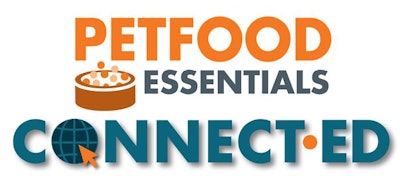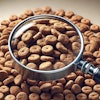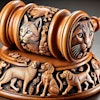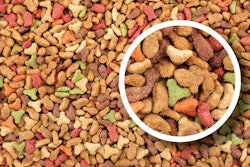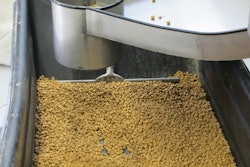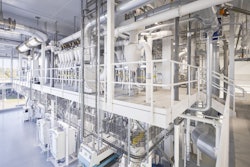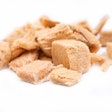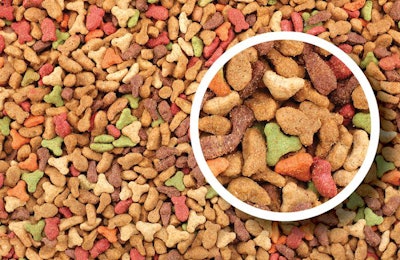
EDITOR’S NOTE: Registration opens this month (September 2020) for Petfood Essentials CONNECT•ED, an on-demand online learning short course offered by Petfood Industry in conjunction with Petfood Forum CONNECT. This program is intended to provide detailed information about the technology and processes involved in production of dry expanded (kibble) pet food. Content experts will lead participants through essential steps along the path toward a better understanding of and appreciation for the process involved with producing these pet foods.
For those not familiar with pet food production or the industry in general, a special series of articles, of which this piece is the second, is intended to provide a high-level, elementary overview of what will be learned in much greater depth during the virtual sessions. The first piece discussed ingredients and preconditioning.
Ingredient acquisition, handling, particle size reduction, weighment, mixing and preconditioning were discussed last month. By the end of that article, the critical details associated with preparation of the ration for extrusion were complete. It was heated and moistened with steam and water, the slurry (if included) was incorporated and thoroughly blended, and the temperature was increased to a point that could, for some companies, be considered the validated kill step — if that was identified as their critical control point (CCP). All the components are “in the mix” short of the fat and flavor coatings. Now the ration should be ready for the heart of producing a kibble — extrusion and drying.
Extrusion: the crunch on crunch
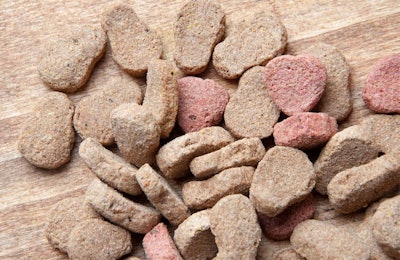
The extrusion and drying steps of kibble production are where the product comes together into what dogs and cats recognize in their bowls. | TBD
Once the preconditioning process is complete, the mash transfers (typically drops by gravity feed) into the extruder. At its simplest, the extruder is a screw or auger within a barrel. It serves several functions: conveyance (pumping), high-intensity mixing (shear), starch cooking (gelatinization), piece formation and expansion. The physics are such that as we increase the flights per turn, it compresses the mash as it moves to the end of the barrel and the pressure increases. This process adds friction (mechanical energy) that is transferred as heat to the product.
The ration particle size, level of moisture and fat can each affect the amount of energy that gets transferred from the screw to the ration. The trick is finding the right combination of screw configuration, revolutions per minute (RPM), pressure, moisture and heat to optimize the process for the individual product. This can be quite different from one product to another and is, in part, the “art” associated with extrusion. Today, more science and engineering are directed to this combination of inputs and have improved the control over the process considerably.
At the end of the barrel, the bulk solid (granular) flour or mash is converted into a molten mass (often called the “melt”) and the remainder of the starch gelatinization occurs. This pressure build-up is made possible by the constant push of the mass by the screw against the backstop of the die plate. At the die plate, a small portion of the melt escapes through the die opening. As it does, water droplets mixed into the melt begin to vaporize and push against the melt creating a foam. The starch freezes (recrystallizes) around the vapor creating voids or cavities and the starch becomes solid again.
In the end, the extruder is a starch-converting or starch-cooking machine. It agglomerates all the ingredients into a singular unit — the kibble or croquette. If we get too much water, too much meat (which brings in water) and/or too much fat, it can affect the outcome of the product. Further, modern pet foods have been de-emphasizing the starch component in lieu of more meat and fat. As a starch-cooking machine, limiting the amount of starch can diminish the amount of expansion that can occur. In those cases, the machine acts more as a forming apparatus, like it would for the semi-moist products, and expansion declines (higher bulk density). This leads to a heavier product that, in some cases, is more friable. For these food forms, a different cooking/forming process may be more advantageous.
Once through the die, the exiting rope of material is cut with a high-speed rotating knife and kibbles are formed. These are then conveyed to a dryer to remove most of the moisture that was added in the process and to help further harden the kibble’s structure.
Drying the extruded kibbles
Today, much of this conveyance from the extruder to the dryer is accomplished with dense phase pneumatic systems that reduce the deformation and breakage associated with traditional belt and screw conveyors, though some still use auger and belt systems. Modern drying equipment involves a massive volume of hot, dry air to take advantage of the differential in moisture that must be removed from the kibble. These drying chambers are typically belted with a bed of kibble being moved from one end to the next, often making two or three passes as it becomes increasingly drier. The process is continuous and matches the inflow from the extruder while allowing the proper amount of time for the moisture trapped within the kibble to exit the structure and exhaust from the equipment.
At the end of this process, kibbles may have been in residence for upwards of 25–30 minutes and may be heated to a temperature exceeding 250F (121C). That is much too hot to package as any latent moisture may still be active in the kibble and could lead to mold growth in the container. The moisture of the kibble starts at ~25–30% and must be dried to below 10–12% and a water activity of 0.65 to 0.70 to be stable from molding. Thus, one must cool the kibble to a level consistent with the packaging material. This is accomplished by the “cooler” — a last leg of the drying process in which ambient air is circulated around the kibble to bring the temperature down and remove any remaining surface moisture.
The combined processes of extrusion and drying are capable of rapidly (minutes) and consistently producing tasty kibbles in large quantity. Physically, the granular ration or mash has been transformed into a piece with a crunchy texture and the starch has been gelatinized to become more nutritionally available with minimal impact to protein quality. While there can be some loss to vitamins during this process, these can be easily adjusted upstream in the formula to assure the food is nutritionally complete and balanced. All that remains is the final phase, which involves coating with fats and flavors and then packaging.
More information and to register for Petfood Essentials CONNECT•ED.
